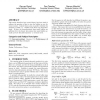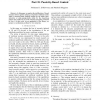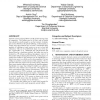42 search results - page 1 / 9 » Part II: control theory for buffer sizing |
CCR
2005
13 years 4 months ago
2005
This article describes how control theory has been used to address the question of how to size the buffers in core Internet routers. Control theory aims to predict whether the net...
CCR
2006
13 years 5 months ago
2006
In the past two years, several papers have proposed rules that suggest two to five orders of magnitude reduction in Internet core router buffers. Others present scenarios where bu...
SIGCOMM
2004
ACM
13 years 10 months ago
2004
ACM
All Internet routers contain buffers to hold packets during times of congestion. Today, the size of the buffers is determined by the dynamics of TCP’s congestion control algor...
CDC
2008
IEEE
13 years 11 months ago
2008
IEEE
— In this paper we explore the stabilization of closed invariant sets for passive systems, and present conditions under which a passivity-based feedback makes the set stable, sem...
CCR
2005
13 years 4 months ago
2005
Internet routers require buffers to hold packets during times of congestion. The buffers need to be fast, and so ideally they should be small enough to use fast memory technologie...



